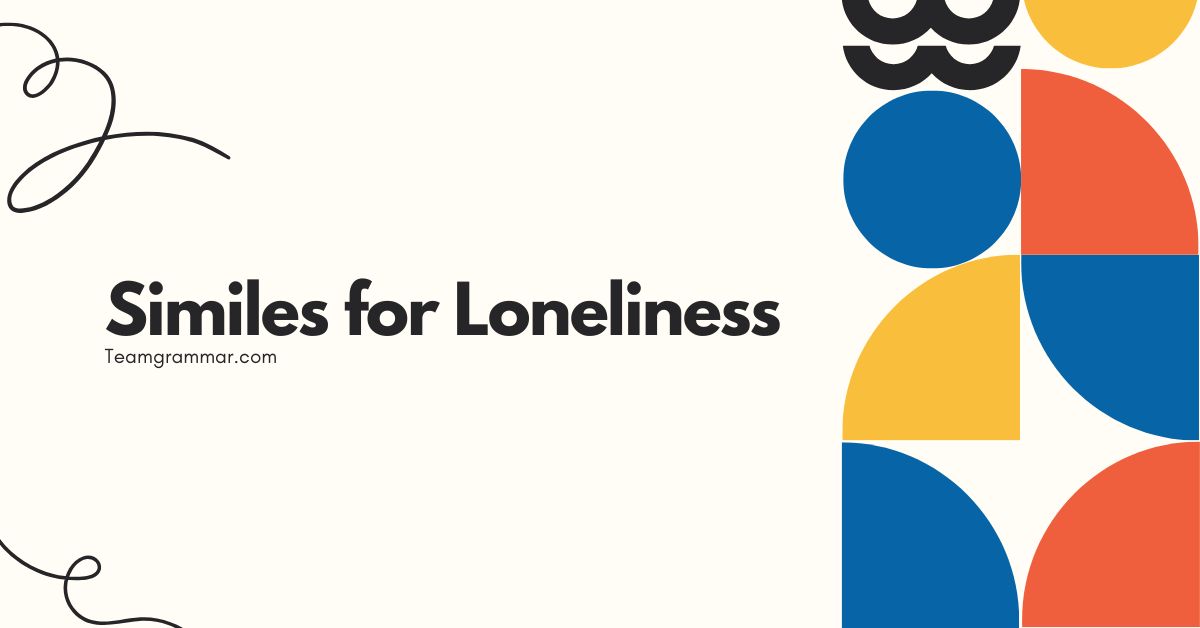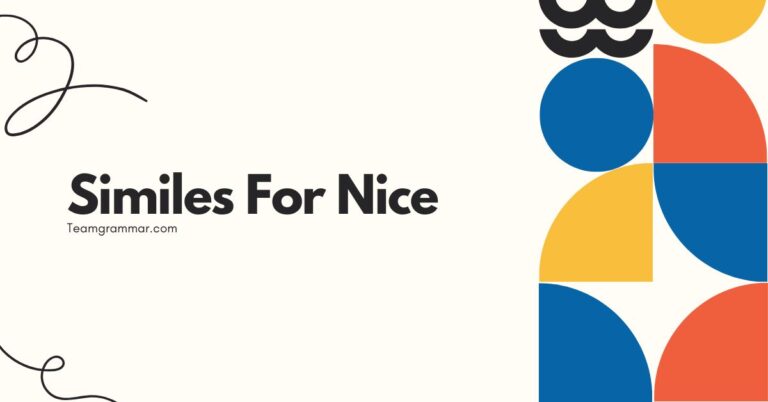41 Similes for Loneliness: A Comprehensive Guide
Understanding how to express complex emotions like loneliness through similes enhances writing and communication skills. Similes, powerful figures of speech, allow us to paint vivid pictures with words, making abstract feelings more relatable.
This guide explores the grammar and usage of similes specifically tailored to describe loneliness. It benefits students, writers, and anyone interested in mastering figurative language to convey deeper meaning.
Table of Contents
- Introduction
- Definition of Similes
- Structural Breakdown of Similes
- Types of Similes
- Examples of Similes for Loneliness
- Usage Rules for Similes
- Common Mistakes with Similes
- Practice Exercises
- Advanced Topics in Similes
- Frequently Asked Questions
- Conclusion
Definition of Similes
A simile is a figure of speech that compares two unlike things using the words “like” or “as.” Its primary function is to create a vivid and relatable image in the reader’s mind by drawing a parallel between something known and something less familiar. Similes are an essential tool in descriptive writing and poetry, allowing authors to convey complex emotions and ideas in an accessible way.
They fall under the broader category of figurative language, which includes metaphors, personification, and hyperbole.
Similes serve to enhance understanding by relating abstract concepts to concrete examples. For instance, saying someone is “as brave as a lion” immediately conveys a sense of courage and fearlessness.
The comparison leverages the widely recognized characteristic of a lion to illustrate the person’s bravery. This technique is particularly effective when describing emotional states, such as loneliness, which can be difficult to articulate directly.
Structural Breakdown of Similes
The basic structure of a simile involves three key components: thesubject, thelinking word(“like” or “as”), and theobject of comparison. The subject is the thing being described, and the object of comparison is what it is being compared to.
The linking word establishes the connection between the two. Understanding this structure is crucial for creating effective and grammatically correct similes.
For example, in the simile “He was as lonely as a cloud,” “He” is the subject, “as” is the linking word, and “a cloud” is the object of comparison. The simile suggests that the person’s loneliness is similar to the solitary nature of a cloud.
The strength of a simile lies in choosing objects of comparison that resonate with the intended meaning and evoke a strong image. The more unexpected yet fitting the comparison, the more impactful the simile becomes.
Types of Similes
While all similes share the same basic structure, they can be categorized based on their effectiveness and the type of comparison they make. Here are a few classifications:
- Simple Similes: These are straightforward comparisons using “like” or “as,” often employing common and easily understood objects of comparison. For example, “as cold as ice.”
- Descriptive Similes: These similes provide more detailed descriptions, adding layers of meaning to the comparison. For example, “as silent as a shadow creeping across the floor.”
- Figurative Similes: These similes use abstract or metaphorical objects of comparison to convey deeper meanings. For example, “like a ship lost at sea,” which suggests a feeling of being directionless and without purpose.
- Humorous Similes: These similes use unexpected or absurd comparisons to create a humorous effect. For example, “as useful as a screen door on a submarine.”
The choice of simile type depends on the desired effect and the context in which it is used. A simple simile is effective for clarity, while a descriptive or figurative simile adds depth and complexity.
Humorous similes can lighten the mood and engage the reader in a playful way. Regardless of the type, the key is to ensure that the comparison is relevant and enhances the overall meaning.
Examples of Similes for Loneliness
Loneliness, being an abstract emotional state, is often best described through similes that evoke relatable imagery. These examples are categorized to illustrate different facets of loneliness.
Feeling Isolated
These similes describe the feeling of being separated or cut off from others, emphasizing the sense of isolation.
The following table illustrates examples of similes used to express the feeling of being isolated. Each example creatively uses “like” or “as” to connect the feeling of loneliness to relatable images, effectively conveying the subject’s sense of separation and disconnection.
| Simile | Explanation |
|---|---|
| As alone as a single tree in a vast desert. | Emphasizes the feeling of being utterly isolated and without companionship. |
| Like a lone wolf howling at the moon. | Conveys a sense of solitary suffering and yearning for connection. |
| As isolated as an island in the middle of the ocean. | Highlights the feeling of being completely cut off from the rest of the world. |
| Like a solitary star in the night sky. | Suggests a sense of beauty and uniqueness, but also profound loneliness. |
| As detached as a satellite orbiting a distant planet. | Implies a feeling of being disconnected and far removed from human interaction. |
| Like a forgotten toy in an attic. | Conveys a sense of being neglected and overlooked. |
| As separate as two ships passing in the night. | Highlights the fleeting nature of connection and the pain of missed opportunities. |
| Like a single grain of sand on a boundless beach. | Emphasizes the feeling of insignificance and anonymity. |
| As lonely as a lighthouse keeper in a storm. | Suggests a sense of responsibility and isolation in the face of adversity. |
| Like a hermit living in a secluded cave. | Conveys a sense of deliberate isolation and withdrawal from society. |
| As alone as a scarecrow in a field. | Highlights the feeling of being stationary and unable to connect with others. |
| Like a shadow detached from its source. | Suggests a sense of incompleteness and lack of identity. |
| As isolated as a prisoner in a solitary cell. | Implies a feeling of confinement and lack of freedom. |
| Like a ghost haunting an empty house. | Conveys a sense of being present but unable to interact with the world. |
| As alone as a deep-sea diver in the abyss. | Highlights the feeling of being surrounded by vastness and emptiness. |
| Like a single leaf falling from a tree. | Evokes the image of being separated from a larger group and drifting aimlessly. |
| As isolated as a voice crying out in the wilderness. | Suggests a sense of being unheard and ignored. |
| Like a lone traveler in a foreign land. | Conveys a sense of displacement and unfamiliarity. |
| As detached as an astronaut floating in space. | Highlights the feeling of being disconnected from Earth and humanity. |
| Like a solitary puzzle piece missing from a set. | Implies a sense of incompleteness and lack of belonging. |
| As alone as a pin drop in a crowded room. | Emphasizes the feeling of being unnoticed and insignificant amidst a crowd. |
| Like a single raindrop falling into the ocean. | Conveys a sense of being lost and absorbed into a larger, indifferent entity. |
| As isolated as a statue in a deserted park. | Highlights the feeling of being immobile and unable to connect with passersby. |
| Like a lone chess piece on an empty board. | Suggests a sense of being out of place and without purpose. |
| As detached as a dream fading into the morning light. | Implies a feeling of impermanence and loss of connection. |
Describing Emptiness
These similes focus on the feeling of hollowness and lack of fulfillment that accompanies loneliness.
The following table provides examples of similes that describe the feeling of emptiness associated with loneliness. These comparisons use vivid imagery to convey the void and lack of fulfillment experienced by the subject.
| Simile | Explanation |
|---|---|
| As empty as a hollow shell. | Emphasizes the feeling of being devoid of substance and meaning. |
| Like a vacant house with no furniture. | Conveys a sense of emptiness and lack of warmth. |
| As barren as a desert landscape. | Highlights the feeling of being unproductive and without potential for growth. |
| Like a well that has run dry. | Suggests a feeling of being depleted and unable to offer anything to others. |
| As hollow as a drum with a broken skin. | Implies a feeling of being unable to resonate with others. |
| Like an empty theater after the show. | Conveys a sense of silence and absence after a period of activity. |
| As void as a black hole in space. | Highlights the feeling of being consumed by nothingness. |
| Like a blank canvas waiting for a painter. | Suggests a feeling of potential, but also a lack of direction. |
| As empty as a promise unfulfilled. | Implies a feeling of disappointment and unfulfilled expectations. |
| Like a ghost town with no inhabitants. | Conveys a sense of desolation and abandonment. |
| As empty as a bird’s nest without eggs. | Emphasizes the feeling of unfulfilled potential and loss. |
| Like a silent movie with no sound. | Suggests a lack of vibrancy and life. |
| As barren as a field after harvest. | Implies a feeling of completion, but also emptiness. |
| Like an unread book on a shelf. | Conveys a sense of being neglected and unappreciated. |
| As empty as a room with no windows. | Highlights the feeling of being trapped and without hope. |
| Like a song with no melody. | Suggests a lack of harmony and beauty. |
| As void as a dream forgotten upon waking. | Implies a feeling of transience and loss. |
| Like an empty glass on a table. | Conveys a sense of unfulfilled desire and thirst. |
| As hollow as a tree struck by lightning. | Highlights the feeling of being damaged and weakened. |
| Like a silent echo in a cave. | Suggests a lack of response and connection. |
| As empty as a wallet with no money. | Emphasizes the feeling of lacking resources and value. |
| Like a story with no ending. | Conveys a sense of incompleteness and dissatisfaction. |
| As barren as a frozen wasteland. | Highlights the feeling of being inhospitable and lifeless. |
| Like an empty swing set in a park. | Suggests a lack of joy and companionship. |
| As void as a computer screen turned off. | Implies a feeling of inactivity and lack of purpose. |
Expressing Abandonment
These similes describe the feeling of being left behind or deserted by others.
The following table provides examples of similes that express the feeling of abandonment. These comparisons use imagery of being left behind and forgotten to convey the emotional impact of abandonment.
| Simile | Explanation |
|---|---|
| As abandoned as a shipwrecked sailor on a deserted island. | Emphasizes the feeling of being stranded and forgotten. |
| Like a stray dog left in the rain. | Conveys a sense of vulnerability and neglect. |
| As deserted as an old mining town. | Highlights the feeling of being left behind after a period of prosperity. |
| Like a broken toy discarded in the street. | Suggests a feeling of being devalued and unwanted. |
| As forlorn as a widow at her husband’s grave. | Implies a feeling of deep sorrow and loss. |
| Like a ghost ship sailing without a crew. | Conveys a sense of aimlessness and lack of direction. |
| As unwanted as a weed in a garden. | Highlights the feeling of being rejected and unwelcome. |
| Like a faded photograph in a dusty album. | Suggests a feeling of being forgotten and out of date. |
| As cast off as a worn-out shoe. | Implies a feeling of being replaced and no longer needed. |
| Like a message in a bottle lost at sea. | Conveys a sense of being unheard and unacknowledged. |
| As abandoned as a house with boarded-up windows. | Emphasizes the feeling of being shut off and neglected. |
| Like a lost child crying in a crowded mall. | Suggests a feeling of vulnerability and fear. |
| As forgotten as a name written in the sand. | Implies a feeling of impermanence and insignificance. |
| Like a bird with a broken wing unable to fly. | Conveys a sense of helplessness and inability to move forward. |
| As stranded as a car with a flat tire on a highway. | Highlights the feeling of being stuck and unable to progress. |
| Like a wilted flower left in a vase. | Suggests a feeling of decay and loss of beauty. |
| As unwanted as a cloudy day during summer vacation. | Implies a feeling of disappointment and unfulfilled expectations. |
| Like a ship without a harbor. | Conveys a sense of being without a safe haven or place to belong. |
| As discarded as yesterday’s newspaper. | Highlights the feeling of being no longer relevant or important. |
| Like a song no one remembers the tune to. | Suggests a feeling of being forgotten and unappreciated. |
| As abandoned as a playground after dark. | Emphasizes the feeling of loneliness and desolation. |
| Like a puppet with its strings cut. | Conveys a sense of being controlled and then discarded. |
| As forsaken as a warrior without a battle to fight. | Highlights the feeling of being without purpose or direction. |
| Like a tree without its roots. | Suggests a feeling of being disconnected and unstable. |
| As rejected as an actor who didn’t get the part. | Implies a feeling of failure and disappointment. |
Conveying Desolation
These similes paint a picture of bleakness and despair, conveying a profound sense of loneliness.
The following table provides examples of similes that convey desolation. These comparisons use bleak and desolate imagery to effectively communicate a profound sense of loneliness and despair.
| Simile | Explanation |
|---|---|
| As desolate as a post-apocalyptic wasteland. | Emphasizes the feeling of utter destruction and emptiness. |
| Like a barren moonscape devoid of life. | Conveys a sense of lifelessness and isolation. |
| As bleak as a winter storm on a frozen sea. | Highlights the feeling of harshness and unforgiving conditions. |
| Like a graveyard shrouded in fog. | Suggests a feeling of death and decay. |
| As grim as a prison cell with no hope of release. | Implies a feeling of confinement and despair. |
| Like a haunted forest filled with shadows. | Conveys a sense of fear and unease. |
| As stark as a bare tree against a gray sky. | Highlights the feeling of emptiness and lack of beauty. |
| Like a ruin crumbling in the desert sun. | Suggests a feeling of decay and loss of glory. |
| As bleak as a landscape after a wildfire. | Implies a feeling of destruction and devastation. |
| Like a tomb sealed forever. | Conveys a sense of finality and hopelessness. |
| As desolate as a ghost town at midnight. | Emphasizes the feeling of abandonment and eeriness. |
| Like a dried-up riverbed in a drought. | Suggests a feeling of depletion and lack of sustenance. |
| As barren as a field of thorns with no flowers. | Implies a feeling of pain and lack of beauty. |
| Like a forgotten path leading nowhere. | Conveys a sense of aimlessness and lack of purpose. |
| As empty as a well with no water. | Highlights the feeling of being unable to provide nourishment or support. |
| Like a broken mirror reflecting nothing. | Suggests a sense of loss of identity and self-worth. |
| As somber as a funeral procession in the rain. | Implies a feeling of grief and sadness. |
| Like a cold wind blowing through an empty house. | Conveys a sense of discomfort and isolation. |
| As dark as a cave with no light. | Highlights the feeling of being lost and without hope. |
| Like a silent scream in the void. | Suggests a feeling of frustration and helplessness. |
| As bleak as a calendar with all the dates crossed out. | Emphasizes the feeling of time passing without purpose or joy. |
| Like a leafless tree in the dead of winter. | Conveys a sense of starkness and lack of vitality. |
| As desolate as a planet with no atmosphere. | Highlights the feeling of being unable to sustain life or connection. |
| Like a broken clock that no longer tells time. | Suggests a feeling of being stuck and unable to move forward. |
| As grim as a gargoyle perched on a crumbling cathedral. | Implies a feeling of decay and impending doom. |
Depicting Detachment
These similes illustrate a sense of emotional disconnection and lack of involvement with the world around.
The following table provides examples of similes that depict detachment. These comparisons use imagery of emotional disconnection and lack of involvement to convey a sense of isolation and indifference.
| Simile | Explanation |
|---|---|
| As detached as an observer watching a play unfold. | Emphasizes the feeling of being uninvolved and distant. |
| Like a ghost drifting through walls, unseen and unheard. | Conveys a sense of invisibility and lack of impact. |
| As indifferent as a stone to the passage of time. | Highlights the feeling of being unaffected by external events. |
| Like a robot programmed to perform tasks without emotion. | Suggests a lack of empathy and human connection. |
| As aloof as a cat watching the world from a high window. | Implies a feeling of superiority and detachment. |
| Like a scientist observing an experiment from behind glass. | Conveys a sense of objectivity and emotional distance. |
| As unconcerned as a cloud floating across the sky. | Highlights the feeling of being carefree and uninvolved. |
| Like a painting hanging on a wall, passively witnessing life. | Suggests a feeling of being a mere observer with no agency. |
| As removed as a memory fading with time. | Implies a feeling of being distant and unreal. |
| Like a dream that disappears upon waking. | Conveys a sense of transience and lack of substance. |
| As apathetic as a judge ruling without sympathy. | Emphasizes the feeling of impartiality and emotional coldness. |
| Like a statue standing in the rain, unmoved and unaffected. | Suggests a feeling of resilience and emotional detachment. |
| As distant as a star light-years away. | Implies a feeling of being unreachable and remote. |
| Like a recording playing without anyone listening. | Conveys a sense of being unheard and unappreciated. |
| As uninvolved as a spectator watching a movie. | Highlights the feeling of being a passive observer with no influence. |
| Like a clock ticking in an empty room. | Suggests a feeling of time passing without purpose or engagement. |
| As detached as an astronaut floating in space. | Implies a feeling of disconnection from Earth and humanity. |
| Like a shadow following someone without interacting. | Conveys a sense of being present but unable to connect. |
| As unmoved as a mountain by the changing seasons. | Highlights the feeling of stability and emotional detachment. |
| Like a camera capturing images without feeling. | Suggests a lack of empathy and emotional involvement. |
| As indifferent as a computer processing data. | Emphasizes the feeling of being logical and unemotional. |
| Like a mirror reflecting images without judgment. | Conveys a sense of objectivity and detachment. |
| As aloof as an emperor surveying his kingdom. | Highlights the feeling of power and emotional distance. |
| Like a spy observing from the shadows. | Suggests a feeling of secrecy and detachment. |
| As unconcerned as a deity watching the world unfold. | Implies a feeling of omnipotence and emotional distance. |
Usage Rules for Similes
To effectively use similes, it’s important to follow certain grammatical rules. The most important rule is to ensure that the two things being compared are indeed unlike.
If they are too similar, the simile loses its impact. For example, comparing “a cat” to “a feline” is not an effective simile because they are essentially the same thing.
Another rule is to choose objects of comparison that are widely understood and evoke a clear image. Using obscure or overly specific references can confuse the reader and diminish the simile’s effectiveness.
Furthermore, similes should be concise and to the point. Overly elaborate similes can become cumbersome and detract from the overall writing.
Consider these points when crafting similes:
- Relevance: Ensure the comparison is relevant to the context and enhances the meaning.
- Clarity: Use objects of comparison that are easily understood.
- Originality: Strive for fresh and unexpected comparisons to make your writing stand out.
- Conciseness: Keep similes brief and impactful.
Common Mistakes with Similes
One common mistake is confusing similes with metaphors. While both are figures of speech that make comparisons, a simile uses “like” or “as,” while a metaphor directly equates two things without using these words.
For example, “He is like a lion” is a simile, while “He is a lion” is a metaphor.
Another common error is using clichés or overused similes. Phrases like “as busy as a bee” or “as strong as an ox” have lost their impact through overuse.
Strive to create original and imaginative comparisons. Also, ensure grammatical correctness.
The subject and object of comparison should agree in number and tense.
Here are some examples of common mistakes and their corrections:
| Incorrect | Correct | Explanation |
|---|---|---|
| He is a lion (when meaning simile). | He is like a lion. | Using a metaphor when a simile is intended. |
| As busy as a bee (cliché). | As busy as a one-armed juggler. | Using an overused simile; replaced with a more original comparison. |
| She runs like a cheetah does. | She runs like a cheetah. | Unnecessary wordiness; simplified for clarity. |
Practice Exercises
Test your understanding of similes with these exercises. Fill in the blanks to complete the similes, or rewrite the sentences using similes to describe loneliness.
Exercise 1: Complete the Similes
Complete the following similes about loneliness by filling in the blanks with appropriate words or phrases. Try to be creative and evocative in your choices.
| Question | Answer |
|---|---|
| 1. He felt as lonely as a ______ in the middle of the night. | 1. He felt as lonely as a graveyard in the middle of the night. |
| 2. She was as isolated as a ______ floating in space. | 2. She was as isolated as a satellite floating in space. |
| 3. The silence was like a ______ echoing through the empty house. | 3. The silence was like a ghost echoing through the empty house. |
| 4. He felt like a ______ lost in a vast desert. | 4. He felt like a traveler lost in a vast desert. |
| 5. Her heart was as empty as a ______ after the party. | 5. Her heart was as empty as a ballroom after the party. |
| 6. The feeling of abandonment was like a ______ clinging to his soul. | 6. The feeling of abandonment was like a shadow clinging to his soul. |
| 7. He felt as detached as a ______ observing the world from afar. | 7. He felt as detached as a scientist observing the world from afar. |
| 8. She was as forlorn as a ______ waiting for a train that never comes. | 8. She was as forlorn as a traveler waiting for a train that never comes. |
| 9. The desolation in his heart was like a ______ stretching to the horizon. | 9. The desolation in his heart was like a wasteland stretching to the horizon. |
| 10. He felt like a ______ shipwrecked on an island of despair. | 10. He felt like a sailor shipwrecked on an island of despair. |
Exercise 2: Rewrite with Similes
Rewrite the following sentences using similes to describe the feeling of loneliness. Focus on creating vivid and evocative comparisons.
| Question | Answer |
|---|---|
| 1. He was very lonely. | 1. He was as lonely as a single star in the vast night sky. |
| 2. She felt isolated from everyone. | 2. She felt like a lone island, separated from the mainland by a wide ocean. |
| 3. The house was empty and silent. | 3. The house was as empty and silent as a tomb. |
| 4. He was abandoned by his friends. | 4. He felt abandoned, like a broken toy discarded in the street. |
| 5. The world seemed bleak and hopeless. | 5. The world seemed as bleak and hopeless as a winter wasteland. |
| 6. She was disconnected from her emotions. | 6. She felt as disconnected from her emotions as a robot programmed for a single task. |
| 7. He was forgotten by everyone. | 7. He was as forgotten as an old photograph in a dusty attic. |
| 8. The silence was oppressive and heavy. | 8. The silence was like a heavy blanket, suffocating and oppressive. |
| 9. She felt insignificant and small. | 9. She felt as insignificant and small as a grain of sand on a vast beach. |
| 10. He was without purpose or direction. | 10. He felt without purpose or direction, like a ship lost at sea without a compass. |
Advanced Topics in Similes
For advanced learners, exploring the nuances of crafting powerful and original similes can significantly enhance writing skills. One advanced technique is to create extended similes, where the comparison is developed over several sentences or even paragraphs.
This allows for a more detailed and impactful image to be created in the reader’s mind.
Another advanced topic is the use of symbolism in similes. By choosing objects of comparison that carry symbolic weight, writers can add layers of meaning to their work.
For example, comparing loneliness to a “ship lost at sea” not only conveys a sense of isolation but also symbolizes the lack of direction and purpose. Furthermore, understanding the cultural context of similes is crucial.
Comparisons that resonate in one culture may not have the same effect in another.
Frequently Asked Questions
- What is the difference between a simile and a metaphor?
A simile compares two unlike things using “like” or “as,” while a metaphor directly equates them without using these words. For example, “He is like a lion” (simile) versus “He is a lion” (metaphor).
- Can a simile use words other than “like” and “as”?
While “like” and “as” are the most common, other words such as “than” or phrases like “similar to” can also be used to create a simile, although these are less frequent.
- How can I avoid using clichés in my similes?
To avoid clichés, brainstorm fresh and original comparisons. Think about unexpected connections between the subject and object of comparison. The more unique the simile, the more impactful it will be.
- What makes a simile effective?
An effective simile is
relevant, clear, original, and concise. It should enhance the meaning, use easily understood objects of comparison, offer a fresh perspective, and be brief and to the point.
- How do I use similes to describe abstract concepts like loneliness?
Use concrete and relatable imagery to convey the abstract feeling. Think about physical sensations, visual scenes, or common experiences that evoke a sense of loneliness. Relate the abstract concept to these tangible elements using “like” or “as.”
Conclusion
Mastering the use of similes is a valuable skill for anyone looking to enhance their writing and communication abilities. By understanding the structure, types, and usage rules of similes, you can effectively convey complex emotions like loneliness in a vivid and relatable way.
Through practice and attention to detail, you can craft powerful and original similes that resonate with your audience and elevate your writing to new heights. Remember to avoid common mistakes, strive for originality, and always ensure that your comparisons are relevant and meaningful.
With these guidelines in mind, you’ll be well-equipped to use similes to their full potential.







